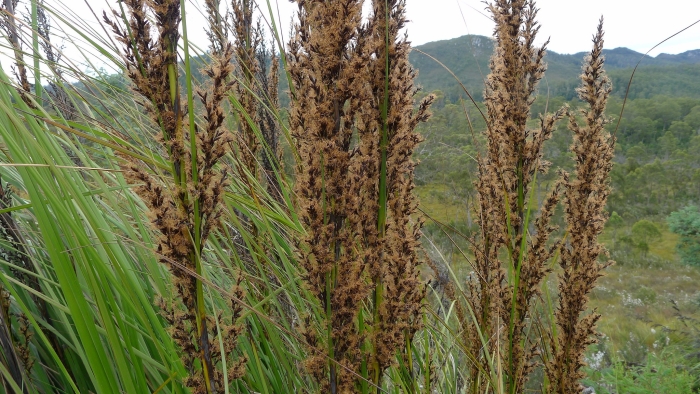Saw Sedge Grass
(Gahnia grandis)
Saw Sedge Grass (Gahnia grandis)
/
/

John Tann
CC BY 2.0
Image By:
John Tann
Recorded By:
Copyright:
CC BY 2.0
Copyright Notice:
Photo by: John Tann | License Type: CC BY 2.0 | License URL: https://creativecommons.org/licenses/by/2.0/ | Uploader: John Tann | Publisher: Flickr |














Estimated Native Range
Summary
Gahnia grandis, commonly known as Saw Sedge Grass, is a semi-deciduous perennial grass native to the coastal swamps, wet heathlands, and forest margins of Eastern Australia and Tasmania. It can grow to a height of 3-9 feet (0.9-2.7 meters) and a width of 6-9 feet (1.8-2.7 meters). This species forms dense tussocks of dark green, strap-like leaves with finely toothed margins that can cut skin, hence the common name. The brownish flower spikes appear in spring and summer and are not particularly showy, but they do add texture to the landscape. The plant’s foliage provides a unique textural contrast in garden settings.
Saw Sedge Grass is valued for its ability to stabilize soil and prevent erosion, making it an excellent choice for planting in challenging areas such as slopes and banks. It is also used in habitat restoration projects and as a protective boundary for wildlife. In cultivation, it requires full sun to part shade, consistent moisture, and can tolerate poorly drained soils. While it is generally low-maintenance, it can be difficult to propagate. Seed germination is the most effective method, as vegetative propagation through division is often unsuccessful. It is important to handle the plant with care due to its sharp-edged leaves.CC BY-SA 4.0
Saw Sedge Grass is valued for its ability to stabilize soil and prevent erosion, making it an excellent choice for planting in challenging areas such as slopes and banks. It is also used in habitat restoration projects and as a protective boundary for wildlife. In cultivation, it requires full sun to part shade, consistent moisture, and can tolerate poorly drained soils. While it is generally low-maintenance, it can be difficult to propagate. Seed germination is the most effective method, as vegetative propagation through division is often unsuccessful. It is important to handle the plant with care due to its sharp-edged leaves.CC BY-SA 4.0
Plant Description
- Plant Type: Grass
- Height: 3-9 feet
- Width: 6-9 feet
- Growth Rate: Moderate
- Flower Color: N/A
- Flowering Season: Summer
- Leaf Retention: Semi-Deciduous
Growth Requirements
- Sun: Full Sun, Part Shade
- Water: Medium
- Drainage: Slow
Common Uses
Bird Garden, Butterfly Garden, Erosion Control, Low Maintenance
Natural Habitat
native to the coastal swamps, wet heathlands, and forest margins of Eastern Australia and Tasmania
Other Names
Common Names:
Scientific Names: , Gahnia grandis, Gahnia psittacorum, Scleria grandis, Cladium psittacorum, Gahnia psilocaulon, Gahnia leucocarpa, Gahnia psittacorum f. leucosperma, Gahnia psittacorum f. psilocaulon, Gahnia psittacorum var. microcarpa
GBIF Accepted Name: Gahnia grandis (Labill.) S.T.Blake